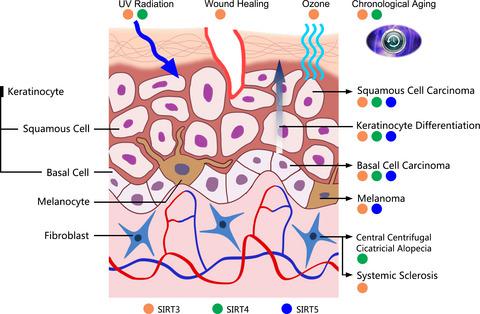当前位置:
X-MOL 学术
›
Photochem. Photobiol.
›
论文详情
Our official English website, www.x-mol.net, welcomes your
feedback! (Note: you will need to create a separate account there.)
Mitochondrial Sirtuins in Skin and Skin Cancers
Photochemistry and Photobiology ( IF 2.6 ) Pub Date : 2020-04-28 , DOI: 10.1111/php.13254 Shengqin Su 1 , Mary Ndiaye 1 , Chandra K Singh 1 , Nihal Ahmad 1, 2
Photochemistry and Photobiology ( IF 2.6 ) Pub Date : 2020-04-28 , DOI: 10.1111/php.13254 Shengqin Su 1 , Mary Ndiaye 1 , Chandra K Singh 1 , Nihal Ahmad 1, 2
Affiliation

|
Mammalian sirtuins (SIRTs 1‐7) are a family of NAD+‐dependent deacetylases with distinct subcellular localization and biological functions that regulate various important cellular processes. Among these, SIRTs ‐3, ‐4 and ‐5 are located in the mitochondria and have been implicated in caloric restriction, oxidative stress, aging and various human diseases. Emerging evidence has found dysregulation of mitochondrial sirtuins in multiple dermatological conditions, including responses to ultraviolet radiation (UVR), suggesting their importance in maintaining skin health. In this review, we discuss the roles and implications of mitochondrial sirtuins in cutaneous cellular processes, and their emerging potential as a target for the management of skin diseases, including skin cancer. Among mitochondrial sirtuins, SIRT3 is the most studied and linked to multiple skin conditions and diseases (keratinocyte differentiation, wound healing, chronological aging, UVR and ozone response, systemic sclerosis, melanoma, basal cell carcinoma (BCC) and squamous cell carcinoma (SCC)). SIRT4 has been connected to keratinocyte differentiation, chronological aging, UVR response, alopecia, BCC and SCC. Further, SIRT5 has been associated with keratinocyte differentiation, melanoma, BCC and SCC. Overall, while there is compelling evidence for the involvement of mitochondrial sirtuins in skin, additional detailed studies are needed to understand their exact roles in skin and skin cancers.
中文翻译:

皮肤和皮肤癌中的线粒体 Sirtuins
哺乳动物 Sirtuins (SIRTs 1-7) 是 NAD+ 依赖性脱乙酰酶家族,具有独特的亚细胞定位和生物学功能,可调节各种重要的细胞过程。其中,SIRT ‐3、‐4 和 ‐5 位于线粒体中,与热量限制、氧化应激、衰老和各种人类疾病有关。新出现的证据发现,多种皮肤病中的线粒体沉默调节蛋白失调,包括对紫外线辐射 (UVR) 的反应,表明它们在维持皮肤健康方面的重要性。在这篇综述中,我们讨论了线粒体 Sirtuins 在皮肤细胞过程中的作用和影响,以及它们作为皮肤病(包括皮肤癌)治疗靶点的新兴潜力。在线粒体sirtuins中,SIRT3 是研究最多的,并且与多种皮肤状况和疾病(角质形成细胞分化、伤口愈合、时间老化、UVR 和臭氧反应、系统性硬化症、黑色素瘤、基底细胞癌 (BCC) 和鳞状细胞癌 (SCC))有关。SIRT4 与角质形成细胞分化、时间老化、UVR 反应、脱发、BCC 和 SCC 相关。此外,SIRT5 与角质形成细胞分化、黑色素瘤、BCC 和 SCC 相关。总体而言,虽然有令人信服的证据表明线粒体 Sirtuins 参与皮肤,但还需要更多详细研究来了解它们在皮肤和皮肤癌中的确切作用。基底细胞癌(BCC)和鳞状细胞癌(SCC))。SIRT4 与角质形成细胞分化、时间老化、UVR 反应、脱发、BCC 和 SCC 相关。此外,SIRT5 与角质形成细胞分化、黑色素瘤、BCC 和 SCC 相关。总体而言,虽然有令人信服的证据表明线粒体 Sirtuins 参与皮肤,但还需要更多详细研究来了解它们在皮肤和皮肤癌中的确切作用。基底细胞癌(BCC)和鳞状细胞癌(SCC))。SIRT4 与角质形成细胞分化、时间老化、UVR 反应、脱发、BCC 和 SCC 相关。此外,SIRT5 与角质形成细胞分化、黑色素瘤、BCC 和 SCC 相关。总体而言,虽然有令人信服的证据表明线粒体 Sirtuins 参与皮肤,但还需要更多详细研究来了解它们在皮肤和皮肤癌中的确切作用。
更新日期:2020-04-28
中文翻译:

皮肤和皮肤癌中的线粒体 Sirtuins
哺乳动物 Sirtuins (SIRTs 1-7) 是 NAD+ 依赖性脱乙酰酶家族,具有独特的亚细胞定位和生物学功能,可调节各种重要的细胞过程。其中,SIRT ‐3、‐4 和 ‐5 位于线粒体中,与热量限制、氧化应激、衰老和各种人类疾病有关。新出现的证据发现,多种皮肤病中的线粒体沉默调节蛋白失调,包括对紫外线辐射 (UVR) 的反应,表明它们在维持皮肤健康方面的重要性。在这篇综述中,我们讨论了线粒体 Sirtuins 在皮肤细胞过程中的作用和影响,以及它们作为皮肤病(包括皮肤癌)治疗靶点的新兴潜力。在线粒体sirtuins中,SIRT3 是研究最多的,并且与多种皮肤状况和疾病(角质形成细胞分化、伤口愈合、时间老化、UVR 和臭氧反应、系统性硬化症、黑色素瘤、基底细胞癌 (BCC) 和鳞状细胞癌 (SCC))有关。SIRT4 与角质形成细胞分化、时间老化、UVR 反应、脱发、BCC 和 SCC 相关。此外,SIRT5 与角质形成细胞分化、黑色素瘤、BCC 和 SCC 相关。总体而言,虽然有令人信服的证据表明线粒体 Sirtuins 参与皮肤,但还需要更多详细研究来了解它们在皮肤和皮肤癌中的确切作用。基底细胞癌(BCC)和鳞状细胞癌(SCC))。SIRT4 与角质形成细胞分化、时间老化、UVR 反应、脱发、BCC 和 SCC 相关。此外,SIRT5 与角质形成细胞分化、黑色素瘤、BCC 和 SCC 相关。总体而言,虽然有令人信服的证据表明线粒体 Sirtuins 参与皮肤,但还需要更多详细研究来了解它们在皮肤和皮肤癌中的确切作用。基底细胞癌(BCC)和鳞状细胞癌(SCC))。SIRT4 与角质形成细胞分化、时间老化、UVR 反应、脱发、BCC 和 SCC 相关。此外,SIRT5 与角质形成细胞分化、黑色素瘤、BCC 和 SCC 相关。总体而言,虽然有令人信服的证据表明线粒体 Sirtuins 参与皮肤,但还需要更多详细研究来了解它们在皮肤和皮肤癌中的确切作用。











































 京公网安备 11010802027423号
京公网安备 11010802027423号